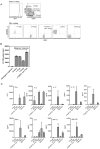Analysis of suppressor and non-suppressor FOXP3+ T cells in HIV-1-infected patients
- PMID: 23285102
- PMCID: PMC3527601
- DOI: 10.1371/journal.pone.0052580
Analysis of suppressor and non-suppressor FOXP3+ T cells in HIV-1-infected patients
Abstract
Recently, it was shown that peripheral blood FOXP3+CD4+ T cells are composed of three phenotypic and functionally distinct subpopulations. Two of them having in vitro suppressive effects were characterized as resting Treg cells (rTregs) and activated Treg cells (aTregs). A third subset, identified as FOXP3+ non-Tregs, does not display any suppressor activity and produce high levels of Th1 and Th17 cytokines upon stimulation. In the present study we focus on the characteristics of these three subsets of FOXP3+CD4+ T cells in untreated HIV-1-infected patients. We found that the absolute counts of rTregs, aTregs and FOXP3+ non-Tregs were reduced in HIV-1 patients compared with healthy donors. The relative frequency of rTregs and aTregs was similar in HIV-1 patients and healthy donors, while the frequency of FOXP3+ non-Tregs was significantly higher in HIV-1 patients, reaching a maximum in those patients with the lower values of CD4 counts. Contrasting with the observations made in FOXP3- CD4+ T cells, we did not find a negative correlation between the number of rTregs, aTregs or FOXP3+ non-Tregs and virus load. Studies performed with either whole PBMCs or sorted aTregs and FOXP3+ non-Tregs cells showed that these two populations of FOXP3+ T cells were highly permissive to HIV-1 infection. Upon infection, FOXP3+ non-Tregs markedly down-regulates its capacity to produce Th1 and Th17 cytokines, however, they retain the ability to produce substantial amounts of Th2 cytokines. This suggests that FOXP3+ non-Tregs might contribute to the polarization of CD4+ T cells into a Th2 profile, predictive of a poor outcome of HIV-1-infected patients.
Conflict of interest statement
Figures





Similar articles
-
FOXP3+Helios+ Regulatory T Cells, Immune Activation, and Advancing Disease in HIV-Infected Children.J Acquir Immune Defic Syndr. 2016 Aug 15;72(5):474-84. doi: 10.1097/QAI.0000000000001000. J Acquir Immune Defic Syndr. 2016. PMID: 27003495 Free PMC article.
-
Regulatory T cell abundance and activation status before and after priming with HIVIS-DNA and boosting with MVA-HIV/rgp140/GLA-AF may impact the magnitude of the vaccine-induced immune responses.Immunobiology. 2018 Dec;223(12):792-801. doi: 10.1016/j.imbio.2018.08.006. Epub 2018 Aug 12. Immunobiology. 2018. PMID: 30121146 Clinical Trial.
-
Dissection of a circulating and intrahepatic CD4(+)Foxp3(+) T-cell subpopulation in chronic hepatitis B virus (HBV) infection: a highly informative strategy for distinguishing chronic HBV infection states.J Infect Dis. 2012 Apr 1;205(7):1111-20. doi: 10.1093/infdis/jis011. Epub 2012 Feb 21. J Infect Dis. 2012. PMID: 22357657
-
The Complex Dysregulations of CD4 T Cell Subtypes in HIV Infection.Int J Mol Sci. 2024 Jul 9;25(14):7512. doi: 10.3390/ijms25147512. Int J Mol Sci. 2024. PMID: 39062756 Free PMC article. Review.
-
Imbalance of Peripheral Lymphocyte Subsets in Patients With Ankylosing Spondylitis: A Meta-Analysis.Front Immunol. 2021 Jul 6;12:696973. doi: 10.3389/fimmu.2021.696973. eCollection 2021. Front Immunol. 2021. PMID: 34295337 Free PMC article.
Cited by
-
Defective IL-17- and IL-22-dependent mucosal host response to Candida albicans determines susceptibility to oral candidiasis in mice expressing the HIV-1 transgene.BMC Immunol. 2014 Oct 26;15:49. doi: 10.1186/s12865-014-0049-9. BMC Immunol. 2014. PMID: 25344377 Free PMC article.
-
Targeting Tuberculosis and HIV Infection-Specific Regulatory T Cells with MEK/ERK Signaling Pathway Inhibitors.PLoS One. 2015 Nov 6;10(11):e0141903. doi: 10.1371/journal.pone.0141903. eCollection 2015. PLoS One. 2015. PMID: 26544592 Free PMC article.
-
Glucose Metabolism in T Cells and Monocytes: New Perspectives in HIV Pathogenesis.EBioMedicine. 2016 Apr;6:31-41. doi: 10.1016/j.ebiom.2016.02.012. Epub 2016 Feb 6. EBioMedicine. 2016. PMID: 27211546 Free PMC article. Review.
-
CD4+FOXP3+ Regulatory T-Cell Subsets in Human Immunodeficiency Virus Infection.Front Immunol. 2013 Jul 30;4:215. doi: 10.3389/fimmu.2013.00215. eCollection 2013. Front Immunol. 2013. PMID: 23908654 Free PMC article.
References
-
- Fontenot JD, Gavin MA, Rudensky AY (2003) Foxp3 programs the development and function of CD4+CD25+ regulatory T cells. Nat Immunol 4: 330–336. - PubMed
-
- Roncador G, Brown PJ, Maestre L, Hue S, Martinez-Torrecuadrada JL, et al. (2005) Analysis of FOXP3 protein expression in human CD4+CD25+ regulatory T cells at the single-cell level. Eur J Immunol 35: 1681–1691. - PubMed
-
- Miyara M, Yoshioka Y, Kitoh A, Shima T, Wing K, et al. (2009) Functional delineation and differentiation dynamics of human CD4+ T cells expressing the FoxP3 transcription factor. Immunity 30: 899–911. - PubMed
Publication types
MeSH terms
Substances
LinkOut - more resources
Full Text Sources
Medical
Research Materials

